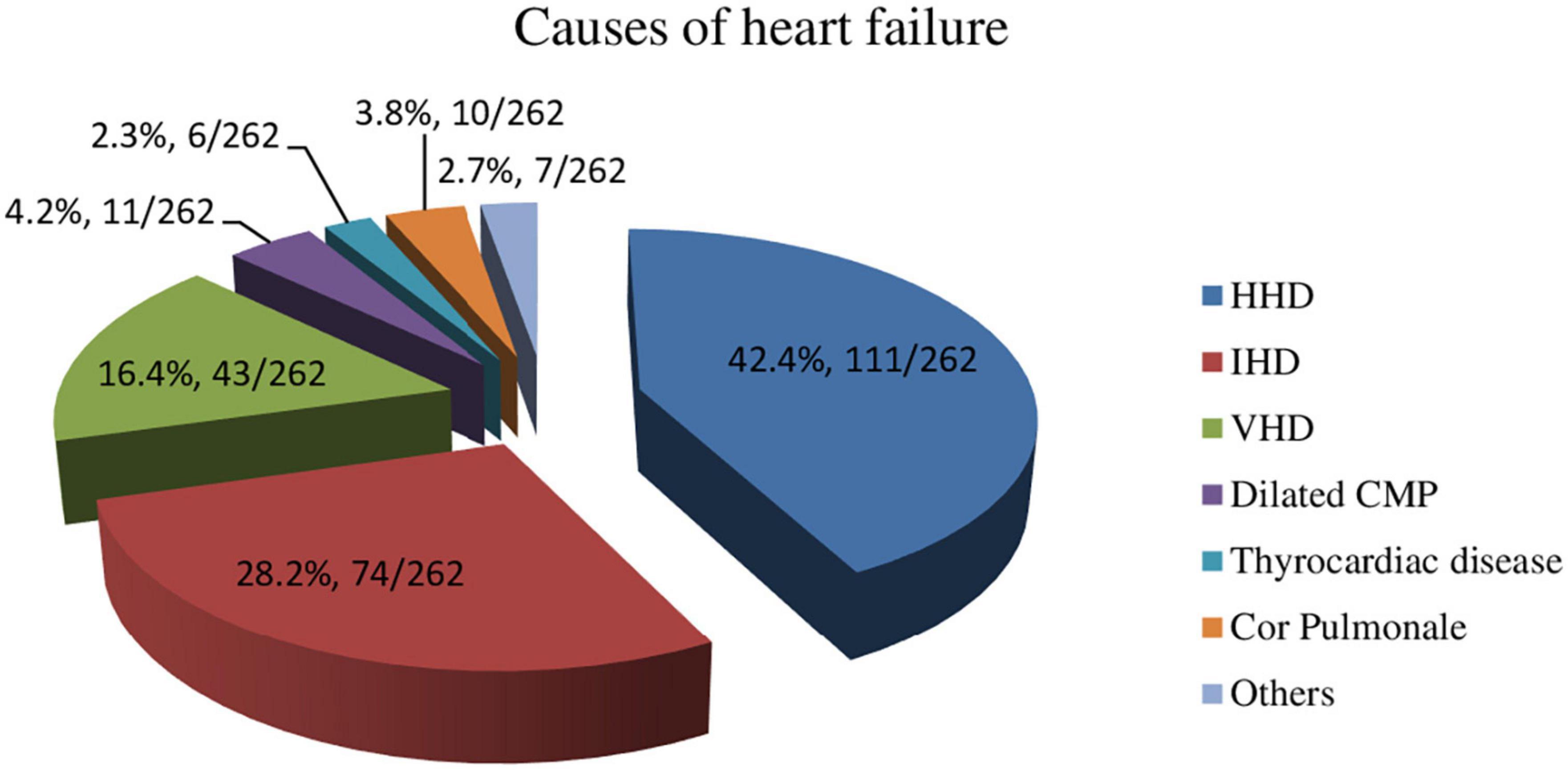- Department of Internal Medicine, School of Medicine, College of Medicine and Health Sciences, University of Gondar, Gondar, Ethiopia
Background: Undernutrition is a frequently noticed medical problem in patients with heart failure. It is caused by poor nutrient intake, malabsorption, systemic inflammation, neurohumoral activation, oxidative stress, and hypermetabolic state. Undernutrition results in a decrease in the quality of life and the survival rate in patients with heart failure. There is a paucity of documentation on undernutrition among patients with heart failure in sub-Saharan African countries. The study aimed to determine the magnitude and associated factors of undernutrition among older adult patients with heart failure in the hospital setting in Northwest Ethiopia.
Methods: An institutional-based cross-sectional study was conducted at the University of Gondar Hospital, Northwest Ethiopia, between 1 June 2021 and 31 October 2021. A consecutive sampling method was used to recruit 262 study subjects. A Mini-nutritional assessment-full form (MNA-FL) Questionnaire was used to extract nutritional information among patients with heart failure. Patients with heart failure, who scored MNA-FL score <17, were declared to have undernutrition. The data were entered into EPI Info version 4.6.0.0 and then exported to SPSS version 26 for analysis. Explanatory variables associated with undernutrition in patients with heart failure were analyzed by applying a logistic regression model. A P-value of <0.05 was used to declare a significant association.
Results: A total of 262 patients with heart failure were included in the study. The mean age (± SD) of the study subjects was 64.6 (± 9.2) years. Hypertensive heart disease (111/262, 42%) was the most common cause of heart failure. Hypertension was the frequently observed comorbid disease. Based on the MNA-FL score for nutritional status, 75 out of 262 (28.6%, 95% CI: 22.9–34.4%) were undernourished (MNA-FL < 17), while 124 out of 262 (47.3%, CI: 41.5–53.1%) were at risk of undernutrition (MNA-FL = 17–23.5). The remaining 63 out of 262 (24.1%, 95% CI: 18.2–29.8%) study subjects were well nourished (MNA-FL > 24). On a multivariate analysis, patients with severe heart failure (New York Heart Association (NYHA) functional class III/IV) (AOR = 4.287, CI: 2.012–9.134, P-value < 0.001), with a duration of illness of 3–5 years (AOR = 3.225, CI: 1.138–9.137, P-value = 0.028), with a duration of illness of >5 years (AOR = 4.349, CI: 1.592–11.879, P-value = 0.001), presence of comorbidities (AOR = 2.29, CI: 1.06–4.96, P-value = 0.036), who underwent treatment with loop diuretics (AOR = 2.983, CI: 1.407–6.326, P-value = 0.040), and who reside in a rural area (AOR = 5.119, CI: 2.481–10.560, P-value < 0.001) were at risk of developing undernutrition.
Conclusion: Undernutrition was a significant clinical problem in older patients with heart failure. Nutritional interventions should be prioritized for patients with chronic and severe heart failure.
Background
Heart failure (HF) is a clinical syndrome that results from structural or functional impairment of ventricular filling or ejection of the blood. It clinically presents with dyspnea and fatigue, which may limit exercise tolerance and fluid retention (1). Heart failure was estimated to affect 1–2% of the adult population worldwide (2). It is estimated that developing countries carry 80% of the global cardiovascular burden (3). Heart failure is frequently associated with malnutrition, termed cardiac wasting or cachexia. It is triggered by poor nutritional intake, malabsorption, systemic inflammation, neurohumoral activation, oxidative stress, and augmented catabolic process (4–7). Malnutrition in heart failure is associated with higher hospital readmission rates and increased mortality rates (7–12). Obese individuals with heart failure were paradoxically associated with improved cardiovascular outcomes and survival, which is referred to as the obesity paradox. However, one-third of elderly obese individuals had a nutritional deficiency and were at risk of adverse cardiovascular outcomes (4, 11, 13, 14). Nutritional interventions could potentially reduce hospital readmission rates and mortality in undernourished patients with heart failure (7, 11, 14–17). However, there is no accepted nutritional guideline for the management of malnutrition among patients with heart failure. There is a scarcity of data on heart failure-related malnutrition rates in sub-Saharan African countries. A single hospital-based study done in Ethiopia documented that more than three-fourths (78%) of patients with heart failure were undernourished (18). There are several techniques used to measure the nutritional status of patients with heart failure. The mini-nutritional assessment (MNA), the controlling nutritional status index (CONUT), the geriatric nutritional risk index (GNRI), the prognostic nutritional index (PNI), the malnutrition universal screening tool (MUST), and the subjective global assessment (SGA) were the frequently used nutritional assessment methods (19, 20). So far, there is no single-standard measuring tool to assess the nutritional status of patients with heart failure. However, MNA surpassed the other nutritional assessment tools in predicting hospital readmission rates, frailty, and mortality rates (7–9, 19, 21). In this study, the mini-nutritional assessment-full form (MNA-FL) nutritional assessment tool was used to determine the nutritional status of the study subjects. Identifying clinical predictors of undernutrition in patients with heart failure would assist in priority setting for nutritional intervention.
Materials and methods
Study settings and design
An institutional-based cross-sectional study was conducted at the Cardiac Clinic, Department of Internal Medicine, University of Gondar Hospital, between 1 June 2021 and 31 October 2021. The hospital is located in Northwest Ethiopia, which is 750 km away from the capital, Addis Ababa. The hospital served a catchment population of 7 million people. The hospital had all the major and minor clinical departments. Department of Internal Medicine was one of the major clinical departments. It had five general wards with 110 beds, one medical ICU with 12 beds, and five outpatient clinics. Other services in the department included multidrug resistant tuberculosis (MDR-TBC) service, dialysis service, endoscopy service, HIV/AIDS care, and chronic illness care. The Cardiac Clinic provided outpatient medical services for patients with cardiac diseases. The clinic was staffed with a cardiologist, internists, medical residents, medical practitioners, and unit nurses. The clinic was equipped with an Echo machine (B/W Digital Ultrasound Scanner, ARI Group, China) and an ECG machine (ECG 1200G, YSIP-155, Beijing, China).
Study population and study subjects
Study population
Adult patients with heart failure were asked to return for follow-up at the Cardiac Clinic of the hospital.
Study subjects
Patients with heart failure aged 50 years or older were asked to return for follow-up at the Cardiac Clinic of the hospital during the study period. Relatively older adult patients with heart failure were recruited to keep measuring the consistency of the MNA-FL score.
Exclusion criteria
Patients with heart failure who were unable to give consent were excluded from the study.
Study variables
Dependent variable: Undernutrition (MNA-FL score < 17).
Independent variables are as follows: (1) sociodemographic characteristics—age, gender, residence, marital status, religion, and educational status; (2) clinical characteristics—cause of heart failure, duration of heart failure, severity of heart failure, comorbidities, and oral cardiac medication types.
Sample size and sampling procedures
The sample size was calculated based on single population proportion formula at a prevalence of undernutrition among patients with heart failure in Southwest Ethiopia was 78%, with a confidence interval of 95% and an assumed margin of error of 5% (14). A consecutive sampling method was used to recruit a sample size of 262 study subjects (22).
Data collection instruments and procedures
Data were collected through a structured questionnaire (MNA-FL). Patients were interviewed to obtain sociodemographic data and relevant medical and nutritional information. Weight (kg), height (m), mid-arm circumference (MAC) (cm), and calf circumference (cm) were measured and a focused clinical examination was carried out for each of the study subjects. Laboratory values were obtained from patients’ records. Echocardiography and ECG tests were carried out on all study subjects to determine the cause of heart failure and document the presence of arrhythmia, respectively.
Mini-nutritional assessment-full form score measurement
Nutritional status as undernutrition, at risk of undernutrition, and normal nutrition was declared by using the MNA-FL score. The MNA-FL score is a single and rapid nutrition assessment tool which was initially developed to assess the nutritional status of the elderly, but it was subsequently being used to assess the nutritional status of patients with chronic illnesses like patients with heart failure, malignancy, and chronic kidney disease. The MNA-FL score includes 18 items grouped into the following four categories: anthropometric assessment (BMI, weight loss, mid-arm, and calf circumferences); general assessment (lifestyle, medication, mobility, presence of depression/dementia, or pressure sores); dietary assessment (number of meals, food and fluid intake, and autonomy of feeding); and subjective assessment (self-perception of health and nutrition). Each answer has a numerical value and contributes to the final score, which has a maximum of 30, with threshold values of ≥24 for subjects who were well nourished, 17–23.5 for subjects at risk of undernutrition, and <17 for subjects who were undernourished (23).
Anthropometric measurement
Body mass index (BMI) was calculated as weight in kilogram divided by height in squared meters (kg/m2). The participant’s weight (kilogram) and height (meters) were measured according to the standard anthropometry procedures to determine the BMI. The adjusted dry weight was used in edematous patients (24). The MAC was measured in the non-dominant hand at a mid-point distance between the shoulder and the elbow. The calf circumference (CC) was measured at the widest circumference of the calf of the non-dominant leg with knee flexion at 90°. The MAC and CC were adjusted by subtracting 2 cm from the measured value in the edematous arm and leg, respectively (24).
Clinical procedures
Twelve-Lead ECG (ECG 1200G, YSIP-155, Beijing, China) was performed for all patients by a physician with a standardization of 1 mV = 10 mm and a paper speed of 25 mm/sec. Abnormal findings on the ECG were interpreted by a cardiologist.
Two-Dimensional Doppler Transthoracic Echocardio-graphy (B/W Digital Ultrasound Scanner, ARI Group, China) was performed for all patients by a cardiologist to determine abnormalities in ventricular ejection fraction, valve morphology, ventricular wall size and motion, and atrial and ventricular chamber dimensions.
Laboratory procedures
Venous blood samples were collected from patients in plain tubes and centrifuged at 2500 rpm for 15 min at room temperature to obtain serum. Mindray BS-480 (Shenzhen Mindray Bio-Medical Electronics Co., Ltd., China) clinical chemistry analyzer was used to determine serum glucose and creatinine values by enzymatic glucose oxidase and kinetic alkaline picrate method, respectively. While radioimmunoassay (RIA) technique (Roche, Switzerland) was used to determine thyroid function tests, and kits were from Beijing Isotope Nuclear Electronic Co., Beijing, China.
Data analysis
Data were entered into and cleaned in EPI Info version 4.6.0.0 (EPI Info, Atlanta, USA) and transported to and analyzed in SPSS version 26 (SPSS Inc., Chicago, USA). Categorical variables were reported as frequencies (percentages) and continuous variables as the mean with standard deviation. The results were summarized using frequency, tables, and graphs. Risk factors for undernutrition were analyzed by applying a logistic regression model. The adequacy of the model was checked by using the Hosmer and Lameshow goodness-of-fit test. Those variables with a P-value of <0.25 in the bivariate analysis were exported to multivariate analysis. The results were presented as an odds ratio with 95% confidence interval. A P-value of <0.05 was used to declare a significant association.
Ethical considerations
The research protocol complied with the Declaration of Helsinki, and ethical clearance was obtained from the Institutional Review Board (IRB) of the College of Medicine and Health Sciences, University of Gondar (02/08/2021, IRB No. 755/2021). Study subjects were recruited only after written informed consent was obtained. All data obtained were treated confidentially. Patients with heart failure were taken care of as per the recommendation of 2013 ACCF/AHA Guideline for the management of heart failure (1).
Definition of terms
Undernutrition: A metabolic state resulting from the lack of intake or uptake of nutrition that leads to altered body composition (decreased fat-free mass) and body cell mass, leading to diminished physical and mental function and impaired clinical outcome from disease (25).
Heart failure: Symptoms and/or signs of heart failure caused by a structural and/or functional cardiac abnormality and corroborated by at least one of the following: elevated natriuretic peptide level or objective evidence of cardiogenic pulmonary or systemic congestion (26).
Hypertensive heart disease: Clinical symptoms and/or signs derived from left ventricular hypertrophy and dysfunction, myocardial ischemia, and rhythm abnormalities, all of them caused by the effects on the heart of chronically elevated blood pressure (27).
Ischemic heart disease: Presence of typical angina with angiography-confirmed coronary artery stenosis, documented prior myocardial infarction, or documented prior coronary artery revascularization (either PCI or CABG) (28).
Comorbidity: Any distinct additional entity that has existed or may occur during the clinical course of a patient who has the index disease under study (29).
Urban population: People living in urban areas as defined by National Statistical Offices (30).
Rural population: People living in rural areas as defined by National Statistical Offices (30).
Results
Sociodemographic characteristics of study participants
A total of 262 patients were included in this study. The mean age (± SD) of the study subjects was 64.6 (± 9.2) years. The majority (138/262, 53%) of the study participants were in the age range of 50–65 years, were women (154/262, 59%), and were rural residents (139/262, 53%) (Table 1).
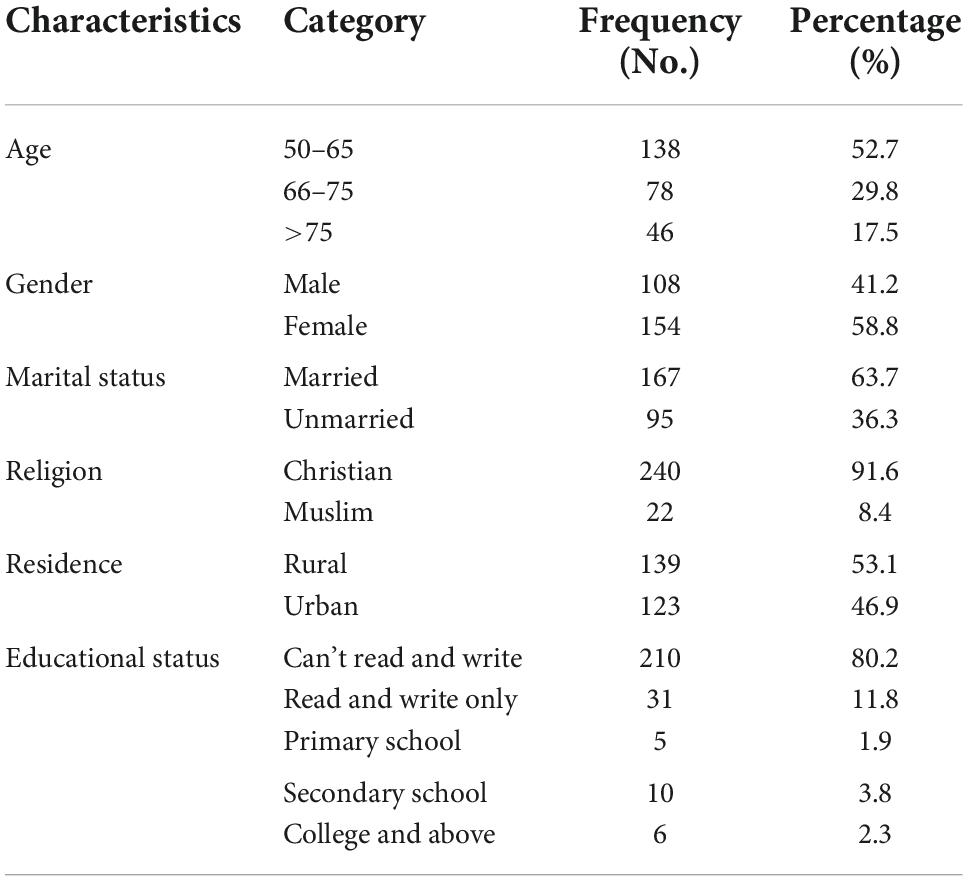
Table 1. Socio-demographic characteristics of older adult patients with heart failure at Cardiac Clinic, University of Gondar hospital, June 01, 2021 to October 31, 2021 (No. 262).
Clinical characteristics of study subjects
Hypertensive heart disease (111/262, 42%) was the most common cause of heart failure, followed by ischemic heart disease (74/262, 28%) and valvular heart disease (43/262, 16%) (Figure 1). Three-fourths (196/262, 75%) of the patients had cardiac disease for three or more years. Two-thirds (164/262, 63%) of the patients had shortness of breath and fatigue while performing ordinary activities (New York Heart Association (NYHA) functional class II). Two-thirds (171/262, 65%) of patients had associated comorbidities. Hypertension (111/171, 65%) was the frequently observed comorbid disease. Angiotensin-converting enzyme inhibitors (180/262, 69%), beta-blockers (157/262, 60%), diuretics (131/262, 50%), aldosterone antagonists (52/262, 20%), and digoxin (22/262, 8%) were the frequently prescribed cardiac medications (Tables 2, 3).
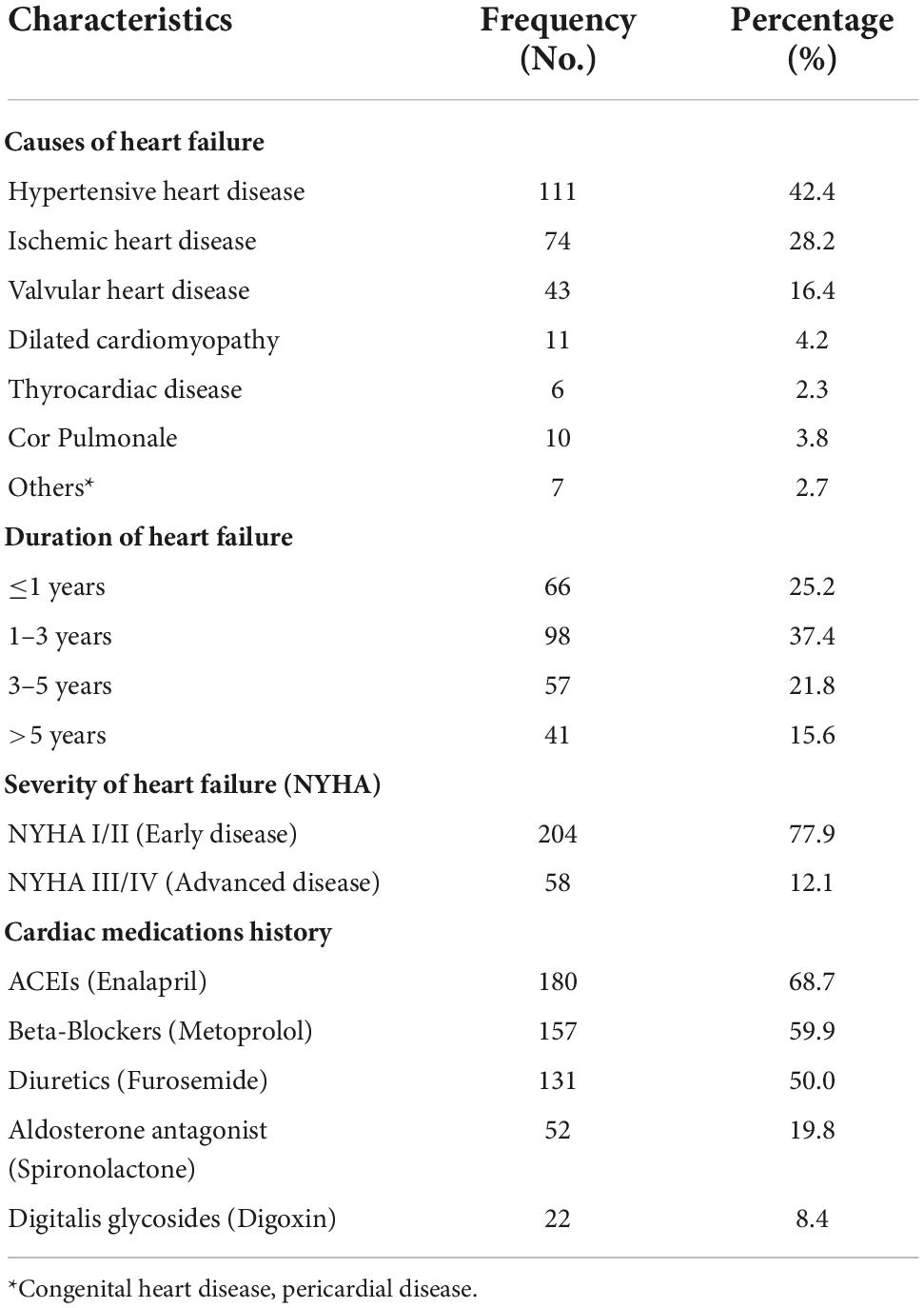
Table 2. Clinical characteristics of older adult patients with heart failure at Cardiac Clinic, University of Gondar hospital, June 01, 2021 to October 31, 2021 (No. 262).
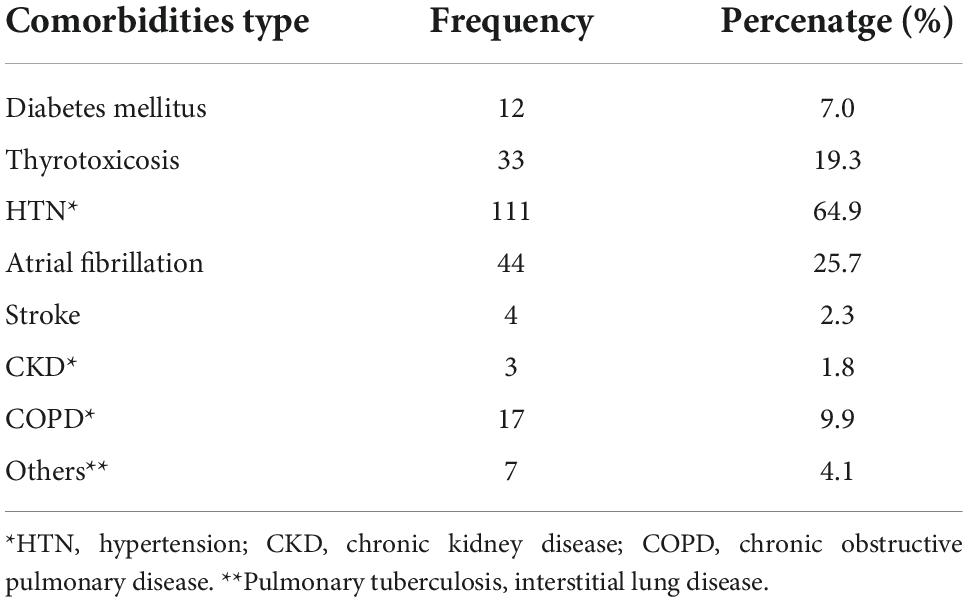
Table 3. Co-morbidities of older adult patients with heart failure at Cardiac Clinic, University of Gondar hospital, June 01, 2021 to October 31, 2021 (No. 171).
Components of mini-nutritional assessment-full form score
Among a total of 262 patients, lower body mass index (BMI < 19 kg/m2), mid-arm circumference (MAC < 21 cm), and calf circumference (CC < 31 cm) were observed in 89/262 (34%), 86/262 (33%), and 135/262 (52%) of the study subjects, respectively (Table 4). Only one-fifth (47/262, 18%) of the study subjects suffered from exacerbation of heart failure in the last 3 months. Most (246/262, 94%) of them went out outdoors and lived independently (246/262, 94%). More than two-thirds (187/262, 71%) of patients were on three or more prescribed drugs (Table 5). More than half (147/262, 52%) of the study subjects did not know their weight loss status in the past 3 months. Two-fifths (103/262, 39%) of the patients had decreased food intake over the past 3 months. Almost all (257/262, 98%) patients got three meals per day. Most (252/262, 96%) of the study subjects got neither dairy products (milk, cheese, or yogurt) nor meat products (meat, fish, or poultry) (260/262, 99.2%) on a daily basis. Most (229/262, 87%) of the study subjects had two or more servings of vegetables per day. Almost all (258/262, 99%) of the study subjects self-fed themselves without any assistance (Table 6). More than half (135/262, 52%) of the study subjects self-perceived as uncertain about their nutritional status. Close to one-third (74/262, 28%) of the study subjects considered themselves to have poor health status as compared to their age matches (Table 7).
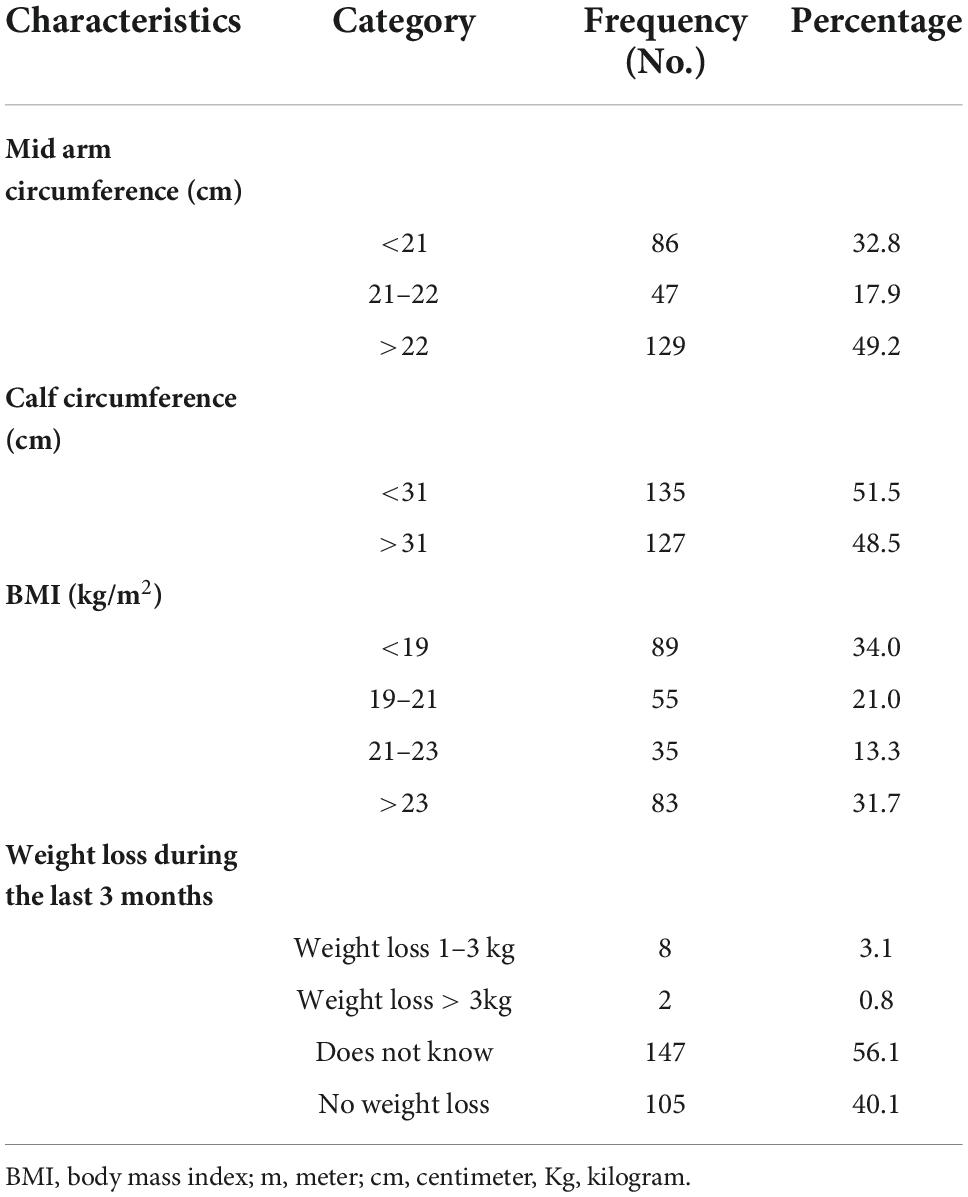
Table 4. Anthropometric assessment of older adult patients with heart failure at Cardiac Clinic, University of Gondar hospital, June 01, 2021 to October 31, 2021 (No. 262).
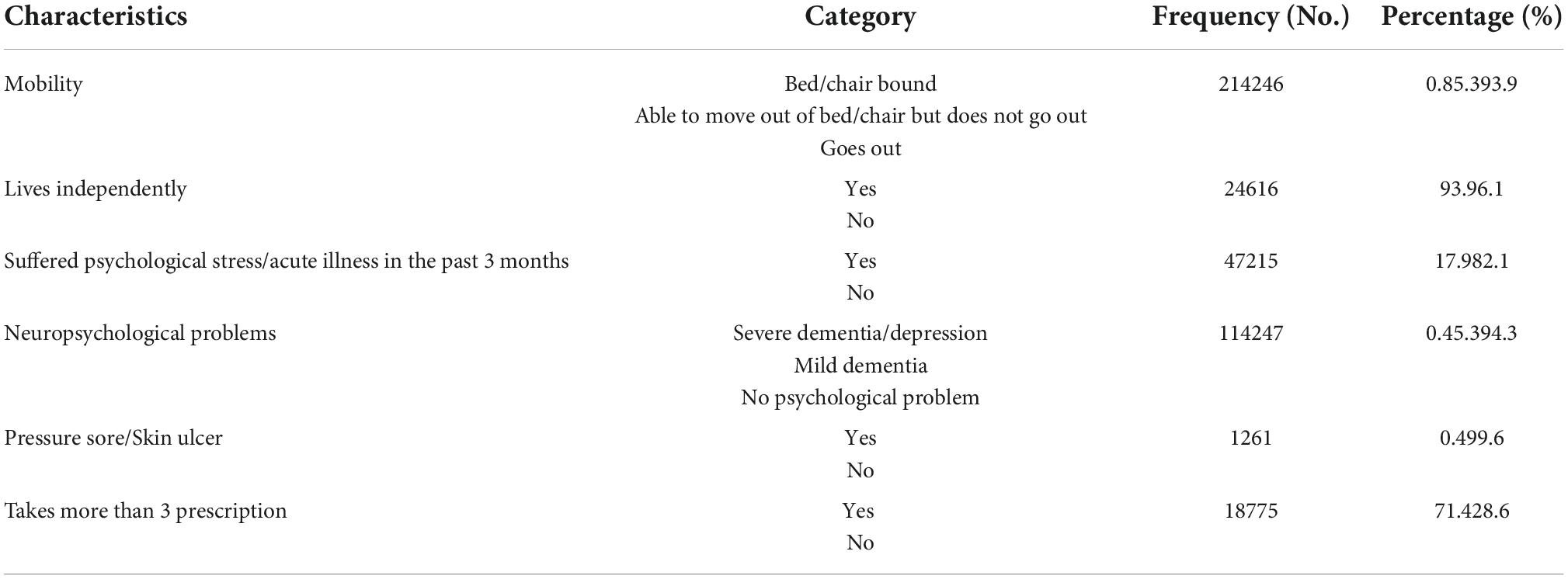
Table 5. General assessment of older adult patients with heart failure at Cardiac Clinic, University of Gondar hospital, June 01, 2021 to October 31, 2021 (No. 262).
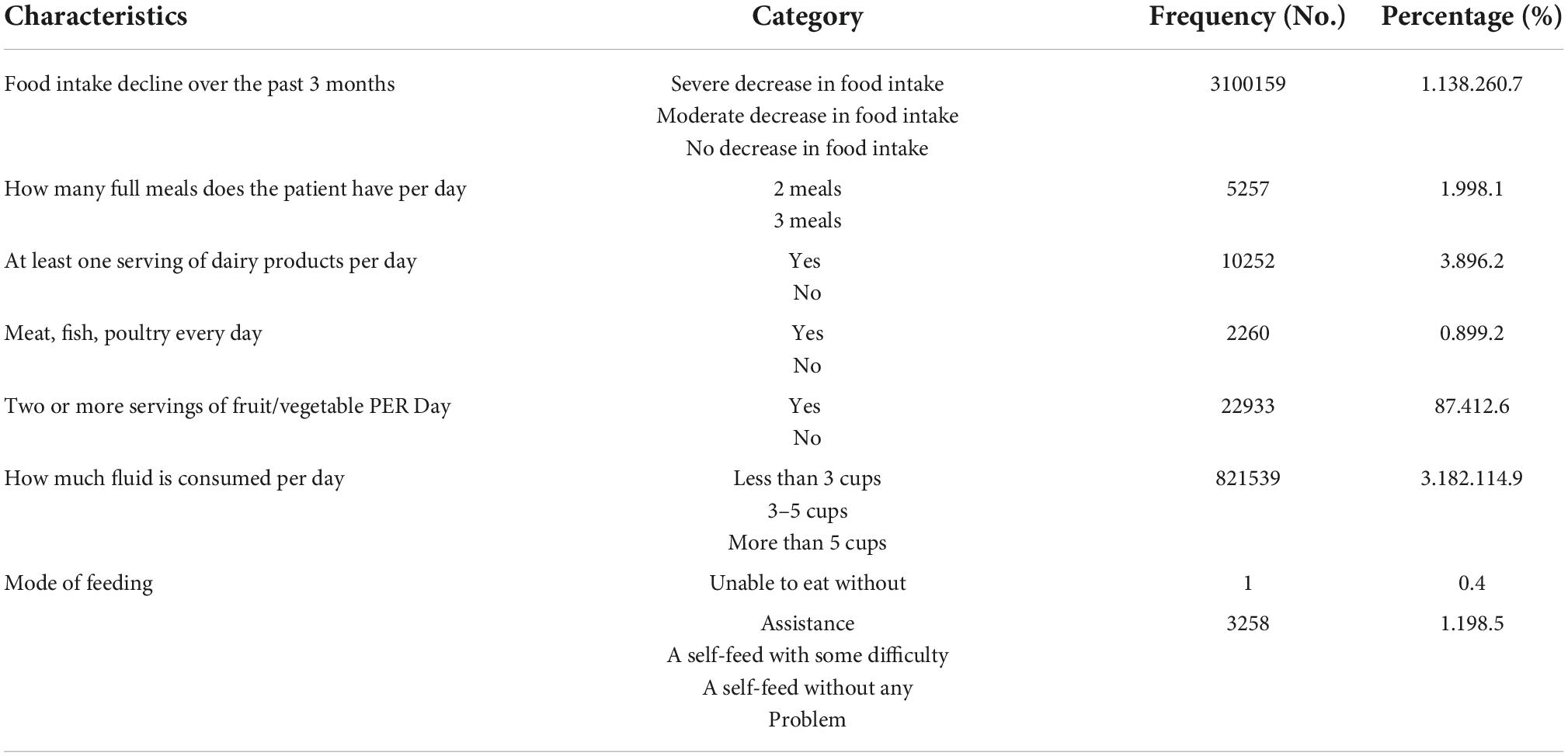
Table 6. Dietary assessment in older adult patients with heart failure at Cardiac Clinic, University of Gondar hospital, June 01, 2021 to October 31, 2021 (No. 262).

Table 7. Self-assessment of older adult patients with heart failure at Cardiac Clinic, University of Gondar hospital, June 01, 2021 to October 31, 2021 (No. 262).
Mini-nutritional assessment-full form score
Based on the MNA-FL score, 75 out of 262 (28.6%, 95% CI: 22.9–34.4%) subjects were undernourished (MNA-FL < 17), while 124 out of 262 (47.3%, CI: 41.5–53.1%) were at risk of undernutrition (MNA-FL = 17–23.5). The remaining 63 out of 262 (24.1%, 95% CI: 18.2–29.8%) study subjects were well nourished (MNA-FL ≥ 24) (Table 8).

Table 8. Mini nutritional assessment (MNA) outcome of older adult patients with heart failure at Cardiac Clinic, University of Gondar hospital, June 01, 2021 to October 31, 2021.
Factors associated with undernutrition in patients with heart failure
Bivariate logistic regression analysis revealed that those patients with severe heart failure (NYHA functional class III/IV), longer duration of illness, presence of comorbidities, treatment with loop diuretics and aldosterone antagonists, and rural residents were at risk of developing undernutrition. However, those treated with ACEIs were protected from undernutrition. When variables with a P-value of <0.25 in bivariate analysis were regressed further in multivariate analysis, patients with severe heart failure (AOR = 4.287, CI: 2.012–9.134, P-value < 0.001), with a duration of illness of 3–5 years (AOR = 3.225, CI: 1.138–9.137, P-value = 0.028), with a duration of illness of >5 years (AOR = 4.349, CI: 1.592–11.879, P-value = 0.001), with the presence of comorbidities (AOR = 2.29, CI: 1.06–4.96, P-value = 0.036), who underwent treatment with loop diuretics (AOR = 2.983, CI: 1.407–6.326, P-value = 0.040), and who were rural residents (AOR = 5.119, CI: 2.481–10.560, P-value < 0.001) were at risk of developing undernutrition (Table 9).
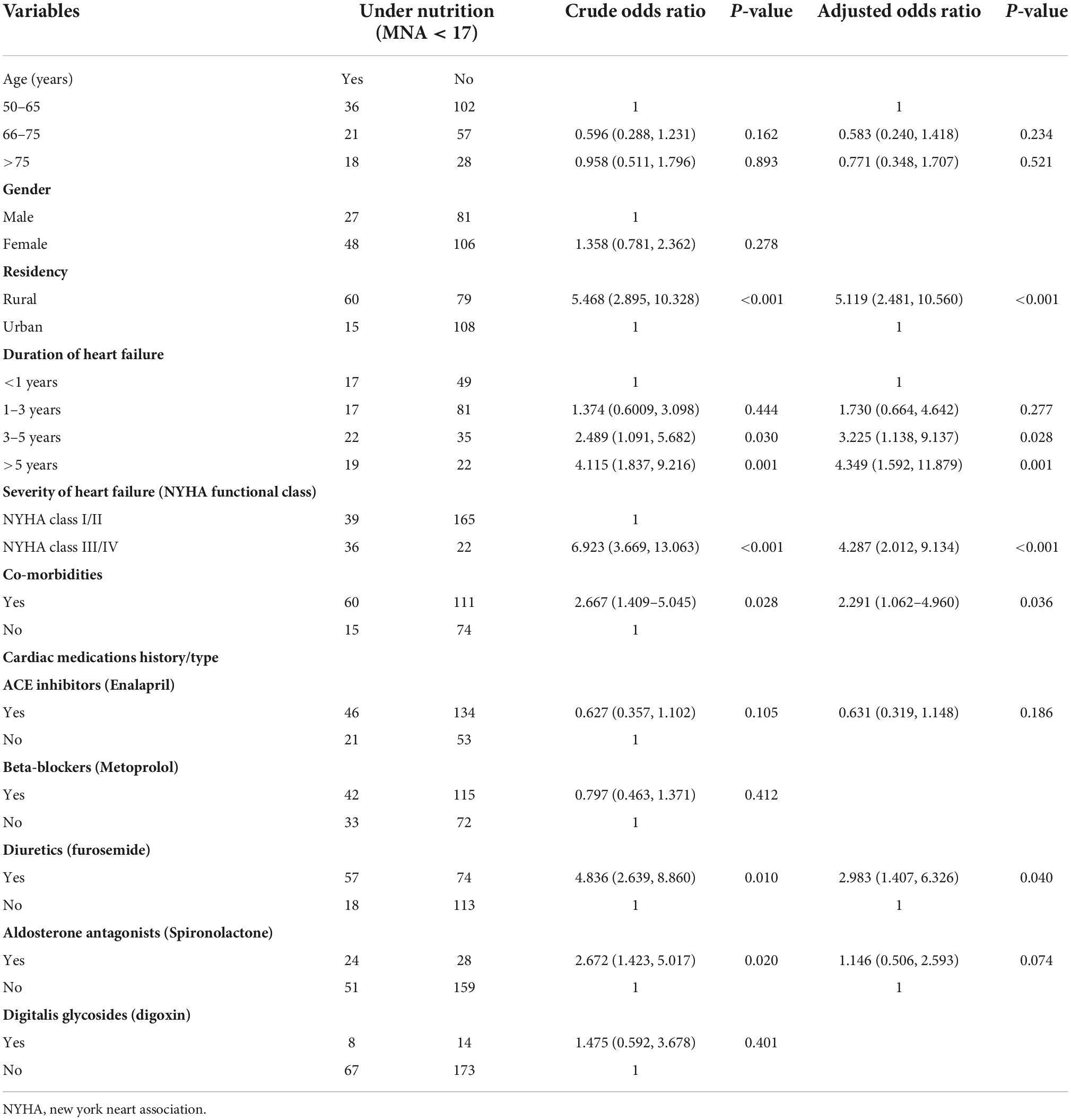
Table 9. Bivariate and multivariate analysis of older adult patients with heart failure at Cardiac Clinic, University of Gondar hospital, June 01, 2021 to October 31, 2021 (No. 262).
Discussion
The magnitude of undernutrition among patients with heart failure was found to be 28.6% (95% CI: 22.9–34.4%). The estimated prevalence of undernutrition was 25–40% from an observational study by Rosa-Maria et al. (9). A recent meta-analysis by Lv et al. documented that the prevalence of undernutrition was 46% (95% CI: 43–49%) (10). It was reported to be 78% in previous studies in Ethiopia (19). The wide-ranging magnitude of the estimated prevalence of undernutrition among patients with heart failure could be explained by the difference in the type of nutritional risk assessment tools used, patient-related characteristics, severity of heart disease, and coexisting comorbidities. Heart failure is significantly associated with protein-calorie undernutrition. Undernutrition in heart failure is triggered by poor appetite and nutritional intake, malabsorption from the gut wall and mucosal abnormalities, hypercytokinemia from systemic inflammation, neurohumoral and immunologic activation, oxidative stress, and excessive resting energy expenditure (REE) from an imbalance in the anabolic–catabolic process (4–7). Cardiac wasting and cachexia are associated with frequent symptom exacerbations, higher hospital readmission rates, longer hospital stay, poor quality of life, and increased mortality rates (7–11). The nutritional intervention had shown to reduce hospital readmission rate and mortality rates in undernourished patients with heart failure (11, 12, 14–16). Increased lean body mass and fat tissue mass after dietary interventions were linked to an increase in the quality of life and better survival, respectively (11, 16, 17). Neurohumoral blockade with ACEIs and beta-blockers showed a survival benefit, improved quality of life, and prevented unintentional weight loss or induced edema-free weight gain (5, 11, 12). Appetite stimulators and anabolic steroids were proven to increase body mass in patients with heart failure in a few clinical trials. However, the harm outweighed the benefit of anti-inflammatory and immunomodulatory drug use. Selective intestinal decontamination to modulate intestinal microflora was not found to be beneficial (4, 5, 11, 16, 17). Hypertensive heart disease accounted for nearly half (42%) of the causes of heart failure. The finding (39%) was congruent with the sub-Saharan African systematic review by Agbor et al. (31). Hypertension (65%) was the commonest comorbid disease. Primary data from Amare et al. and systemic review by Agbor VN, et al. documented that hypertension was the frequently observed (36–39%) comorbid disease (18, 31). On multivariate logistic regression analysis, severe heart failure, longer duration of cardiac disease, coexisting comorbidities, use of loop diuretics, and rural residence were significantly associated with undernutrition in patients with heart failure. Patients with severe heart failure (NYHA functional class III/IV) were four times more at risk of developing undernutrition as compared to those with mild heart failure (NYHA functional class I/II) (AOR = 4.287, CI: 2.012–9.134, P-value < 0.001). A review by Dunn et al. documented that there was an increased incidence of nutritional wasting with the severity of heart failure, ranging from 22% in heart failure NYHA class II to 63% in heart failure NYHA class III (11). Similarly, exacerbated nutritional wasting was observed among patients with advanced heart failure from a report by Kaluzna-Oleksy et al. (12). A study by Rosa-Maria et al. recognized that undernutrition was a mediator of disease progression and determining prognosis in advanced heart failure (10). Patients with a longer duration of cardiac illness (≥3 years) were three to four times more likely to develop undernutrition as compared to those with a shorter duration of cardiac illness (<3 years). Various studies showed that chronicity in heart failure was associated with maladaptive neurohumoral activation, hypercytokinemia, and hypercatabolic state, which resulted in malnutrition–inflammation–cachexia (MIC) (4–6, 14). The odds of developing undernutrition were 2-fold higher in those who had comorbidities as compared to those who had not (AOR = 2.29, CI: 1.06–4.96, P-value = 0.036). The identified comorbidities among study subjects were known to cause hypercytokinemia from systemic inflammation and excessive REE from an increased catabolic state. The odds of developing undernutrition were three times higher in patients who were on diuretic therapy as compared to those who were not (AOR = 2.983, CI: 1.407–6.326, P-value = 0.040). It could be partly explained by diuretic-induced excessive renal loss of micronutrients and trace elements, or those patients on diuretic treatment might have advanced heart failure (11). Patients from rural areas were five times more at risk of developing undernutrition as compared to urban dwellers (AOR = 5.119, CI: 2.481–10.560, P-value < 0.001). This finding might be explained by differences in dietary habits and socioeconomic conditions among urban and rural dwellers in the catchment area. A study done in South Africa documented that urbanization was associated with an increased intake of fat, meat, sugar, and beverages. Rural residents often consumed traditional foodstuffs and had limited food choices (32).
Limitations of the study
The cross-sectional study design might have a limitation on causal relationships and the absence of a control arm. The study subjects were relatively older adult patients, who might not be a true representative of the catchment population. In addition, the convenience sampling method was used, which might introduce selection bias.
Conclusion
Undernutrition was a significant clinical problem in older adult patients with heart failure. Chronic and severe heart failure, presence of comorbidities, treatment with diuretics, and rural residence were significant predictors of undernutrition in patients with heart failure.
Data availability statement
The raw data supporting the conclusions of this article will be made available by the authors, without undue reservation.
Ethics statement
The studies involving human participants were reviewed and approved by Institutional Review Board (IRB) of the College of Medicine and Health Sciences, University of Gondar (02/08/2021, IRB No. 755/2021). The patients/participants provided their written informed consent to participate in this study.
Author contributions
HuA contributed to the conception, design, data collection, analysis, writing, and review of the manuscript. AT contributed to the conception, design, analysis, writing, and review of the manuscript. HaA, AA, and MT contributed to the conception, design, analysis, and review of the manuscript. All authors read and approved the final manuscript and approved its submission for publication.
Funding
This study was funded by the research was obtained from the “Research and Publication Office” of the College of Medicine and Health Sciences, University of Gondar. The funding body had no role in the design of the study, data collection, analysis, and interpretation of the data.
Acknowledgments
The authors are grateful to thank the study participants and their health personnel.
Conflict of interest
The authors declare that the research was conducted in the absence of any commercial or financial relationships that could be construed as a potential conflict of interest.
Publisher’s note
All claims expressed in this article are solely those of the authors and do not necessarily represent those of their affiliated organizations, or those of the publisher, the editors and the reviewers. Any product that may be evaluated in this article, or claim that may be made by its manufacturer, is not guaranteed or endorsed by the publisher.
Abbreviations
ACCF, American College of Cardiology Foundation; ACEIs, angiotensin converting enzyme inhibitors; AHA, American Heart Association; AOR, adjusted odds ratio; BMI, body mass index; CABG, coronary artery bypass graft; CC, calf circumference; CHF, congestive heart failure; CI, confidence interval; COR, crude odds ratio; Cm, centimeter; Echo, echocardiography; ECG, electrocardiography; IRB, Institutional Review Board; Kg, kilogram; M, meter; MAC, mid-arm circumference; MIC, malnutrition-inflammation-cachexia; MNA-FL, mini-nutritional assessment-full form; NYHA, New York Heart Association; PCI, percutaneous coronary intervention; REE, resting energy expenditure; SD, standard deviation.
References
1. Yancy C, Jessup M, Bozkurt B, Butler J, Casey D, Drazner M, et al. 2013 ACCF/AHA guideline for the management of heart failure a report of the American college of cardiology foundation/American heart association task force on practice guidelines. J Am Coll Cardiol. (2013) 62:e147–239. doi: 10.1161/CIR.0b013e31829e8776
2. Lippi G, Sanchis-Gomar F. Global epidemiology and future trends of heart failure. Am Med J. (2020) 5:15–21. doi: 10.21037/amj.2020.03.03
3. Groenewegen A, Rutten F, Mosterd A, Hoes A. Epidemiology of heart failure. Eur J Heart Fail. (2020) 22:1342–56. doi: 10.1002/ejhf.1858
4. Rahman A, Jafry S, Jeejeebhoy K, Nagpal A, Pisani B, Agarwala R, et al. Malnutrition and cachexia in heart failure. JPEN J Parenter Enteral Nutr. (2016) 40:475–86. doi: 10.1177/0148607114566854
5. Okoshi M, Romeiro F, Paiva S, Okoshi K. Heart failure-induced cachexia. Arq Bras Cardiol. (2013) 100:476–82. doi: 10.5935/abc.20130060
6. Da Fonseca G, van Haehling S. Sarcopenia complicating heart failure. Eur Heart J. (2019) 21:L20–3. doi: 10.1093/eurheartj/suz240
7. Fernandez-Pombo A, Rodriguez-Carnero G, Castro A, Canton-Blanco A, Seoane C, Casanueva F, et al. Relevance of nutritional assessment and treatment to counteract cardiac cachexia and sarcopenia in chronic heart failure. Clin Nutr. (2021) 40:5141–55. doi: 10.1016/j.clnu.2021.07.027
8. Bonilla-Palomas J, Gámez-López A, Moreno-Conde M, López-Ibáñez M, Castellano-García P, Ráez-Ruiz C, et al. Impact of malnutrition on long-term mortality in outpatients with chronic heart failure. Nutr Hosp. (2017) 34:1382–9. doi: 10.20960/nh.1131
9. Rosa-Maria, A, Ferreiro-Rocio G, Roman-Alfonso V, Otero-Ines G, Omar K, Sabaris-Patricia C, et al. Nutritional status is related to heart failure severity and hospital readmission in acute heart failure. Internat J Cardiol. (2016) 230:108–114. doi: 10.1016/j.ijcard.2016.12.067
10. Lv S, Ru S. The prevalence of malnutrition and its effects on the all-cause mortality among patients with heart failure: a systematic review and meta-analysis. PLoS One. (2021) 16:e0259300. doi: 10.1371/journal.pone.0259300
11. Dunn S, Bleske B, Dorsch M, Macaulay T, van Tassell B, Vardeny O. Nutrition and heart failure: impact of drug therapies and management strategies. Nutr Clin Pract. (2009) 24:60–75. doi: 10.1177/0884533608329299
12. Kaluzna-Olesky M, Krysztofiak H, Migaj J, Wleklik M, Dudek M, Uchmanowicz I, et al. Relationship between nutritional status and clinical and biochemical parameters in hospitalized patients with heart failure with reduced ejection fraction, with 1-year follow-up. Nutrients. (2020) 12:2330–47. doi: 10.3390/nu12082330
13. Soyal P, Okudur S, Kilic N, Ipar O, Smith L. The prevalence of undernutrition and associated factors in older obese patients. Aging Clin Exp Res. (2022) 34:2023–30. doi: 10.1007/s40520-022-02143-7
14. Kalantar-zadeh K, Anker S, Horwich T, Fonarow G. Nutritional and anti-inflammatory interventions in chronic heart failure. Am J Cardiol. (2008) 101:89E–103. doi: 10.1016/j.amjcard.2008.03.007
15. Bonilla-Palomas J, Gamez-Lopez A, Castillo-Dominguaz J, Moreno-Conde M, Lopez-Ibanoz M, Alahmbra-Exposito K, et al. Nutritional intervention in malnourished hospitalized patients with heart failure. Arch Med Res. (2016) 47:535–40. doi: 10.1016/j.arcmed.2016.11.005
16. Billingsley H, Hummel S, Carbone S. The role of diet and nutrition in heart failure. A state-of –the-art narrative review. Prog Cardiovasc Dis. (2020) 63:538–51. doi: 10.1016/j.pcad.2020.08.004
17. Habaybeh D, de Moraes M, Slee A, Avgerinou C. Nutritional interventions for heart failure patients who are malnourished or at risk of malnutrition or cachexia: a systematic review and meta-analysis. Heart Fail Rev. (2021) 26:1103–18. doi: 10.1007/s10741-020-09937-9
18. Amare H, Hamza L, Asefa H. Malnutrition and associated factors among heart failure patients on follow up at Jimma university specialized hospital, Ethiopia. BMC Cardiovasc Disord. (2015) 15:128. doi: 10.1186/s12872-015-0111-4
19. Lin H, Zhang H, Lin Z, Li X, Kong X, Sun G. Review of nutritional screening and assessment tools and clinical outcomes in heart failure. Heart Fail Rev. (2016) 21:549–65. doi: 10.1007/s10741-016-9540-0
20. Jayawardena R, Lokunarangoda N, Ranathunga I, Santharaj W, Walawwatta A. Pathirana. Predicting clinical outcome of cardiac patients by six malnutrition screening tools. BMC Nutr. (2016) 2:5. doi: 10.1186/s40795-016-0044-z
21. Soyal P, Veronese N, Arik F, Kalan U, Smith L, Isik A. Mini nutritional assessment scale-short form can be useful for fraility screening in older adults. Clin Interv Aging. (2019) 14:693–9. doi: 10.2147/CIA.S196770
22. Daniel W. Biostatistics: A Foundation for Analysis in the Health Sciences. Toronto: John Wiley & Sons (1991). p. 209–15.
23. Guigoz Y, Vellas B, Garry P. Assessing the nutritional status of the elderly: the mini nutritional assessment as part of the geriatric evaluation. Nutr Rev. (1996) 54:S59–65. doi: 10.1111/j.1753-4887.1996.tb03793.x
24. Lahner C. Adult weight measurement: decoding the terminology used in literature. S Afr J Clin Nutr. (2018) 32:28–31. doi: 10.1080/16070658.2018.1426186
25. Cederholm T, Barazzoni R, Austin P, Ballmer P, Biolo G, Bischoff S, et al. ESPEN guidelines on definitions and terminology of clinical nutrition. Clin Nutr. (2017) 36:49–64. doi: 10.1016/j.clnu.2016.09.004
26. Bozkurt B, Coats A, Tsutsui H, Abdelhamid C, Adamopoulos S, Albert N, et al. Universal definition and classification of heart failure: a report of the heart failure assocation of the European society of cardiology, Japanese heart failure society and writing committee of the universal defintion of heart failure. Eur J Heart Fail. (2021) 23:352–80. doi: 10.1002/ejhf.2115
27. Algeria-Ezquerra E, Gonzalez-Juanatey J, Gonzalez-Maqueda I. Hypertensive heart disease: a proposed clinical classification. Rev Esp Cardiol. (2006) 59:397–401. doi: 10.1016/S1885-5857(06)60781-0
28. Cannon C, Brindis R, Chaitman B, Cohen D, Cross J, Brazda JP Jr, et al. 2013 ACCF/AHA key data elements and definition for measuring the clinical management and outcomes of patients with acute coronary syndromes and coronary artery disease: a report of the American college of cardiology foundation/American heart association task force on clinical data standards (writing committee to develop acute coronary syndromes and coronary artery disease clinical data standards). Circulation. (2013) 127:1052–89. doi: 10.1016/j.jacc.2012.10.005
29. Valderas J, Starfield B, Sibbald B, Salisbury C, Roland M. Defining comorbidity: implications for understanding health and health services. Ann Fam Med. (2009) 7:357–63. doi: 10.1370/afm.983
30. The World Bank Group. Metadata Glossary- World Bank Data Bank. Washington, DC: The World Bank Group (2022).
31. Agbor V, Essouma M, Ntusi N, Nyaga U, Bigna J, Noubiap J. Heart failure in Sub-Saharan Africa: a contemporaneous systematic review and meta-analysis. Internat J Cardiol. (2017) 257:207–15. doi: 10.1016/j.ijcard.2017.12.048
Keywords: heart failure, undernutrition, MNA-FL score, University of Gondar, Ethiopia
Citation: Ahmed H, Tadesse A, Alemu H, Abebe A and Tadesse M (2022) Undernutrition was a prevalent clinical problem among older adult patients with heart failure in a hospital setting in Northwest Ethiopia. Front. Nutr. 9:962497. doi: 10.3389/fnut.2022.962497
Received: 06 June 2022; Accepted: 10 November 2022;
Published: 01 December 2022.
Edited by:
Manuela Morato, University of Porto, PortugalReviewed by:
Pınar Soysal, Bezmiâlem Vakıf Üniversitesi, TurkeyDesalew Mekonnen, Addis Ababa University, Ethiopia
Copyright © 2022 Ahmed, Tadesse, Alemu, Abebe and Tadesse. This is an open-access article distributed under the terms of the Creative Commons Attribution License (CC BY). The use, distribution or reproduction in other forums is permitted, provided the original author(s) and the copyright owner(s) are credited and that the original publication in this journal is cited, in accordance with accepted academic practice. No use, distribution or reproduction is permitted which does not comply with these terms.
*Correspondence: Abilo Tadesse, YWJpbG90YWRAZ21haWwuY29t
 Hussen Ahmed
Hussen Ahmed Abilo Tadesse
Abilo Tadesse Hailemaryam Alemu
Hailemaryam Alemu Melaku Tadesse
Melaku Tadesse